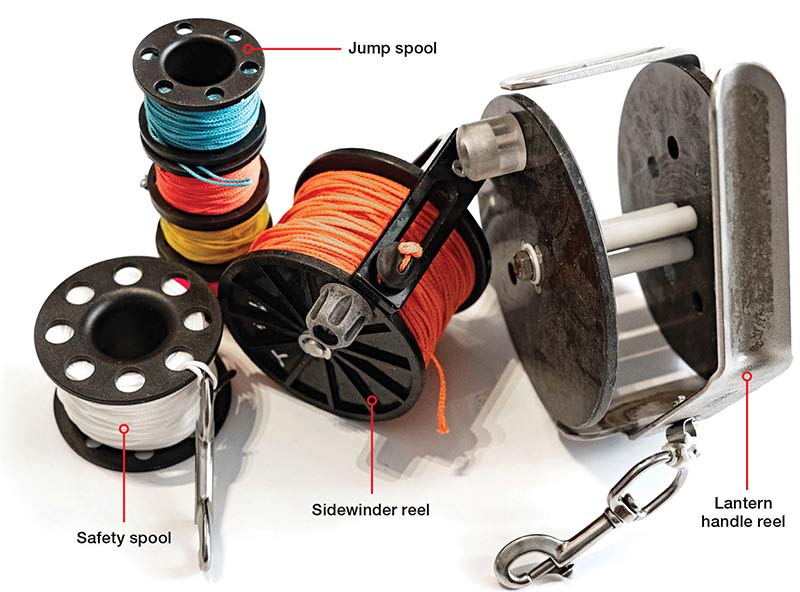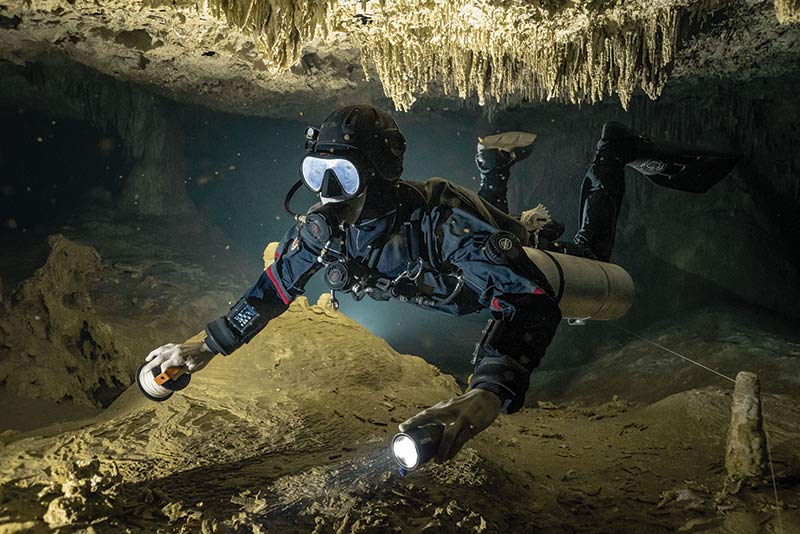Choosing the Perfect Reel

By Natalie Gibb
A quick googling of “scuba diving reels” results in over 1,330,000 results. There’s an overwhelming number of options, and one might assume that if a commercial dive gear company makes the effort to design and manufacture a reel or spool, that it would be good. Sadly, this is not the case, and there is a great deal of cheap junk available, and even some of the quality reels are not appropriate for cave diving. Here’s a reel deep look into features and considerations when selecting a cave diving reel.
Reels vs spools
Those who are not familiar with cave diving jargon often use the terms ‘reel’ and ‘spool’ interchangeably, but in this sport they are not the same thing. The difference is simple: a reel has a handle and a spool does not. Both can be useful for cave diving, and which you choose to use will depend upon the application.
Reels can be preferable for cold water applications that require a diver to wear dry gloves, mitts, or even thick neoprene gloves that reduce dexterity. Reels are also much faster to retrieve. For this reason, reels are often preferred for sites with strong flow, and for situations in which a diver must place a long section of line. However, reels are significantly more expensive than spools, and they are heavier and bulkier so it can be uncomfortable carrying a large number of reels for a dive requiring numerous jumps.
Spools, on the other hand, are extremely simple with no moving parts. A diver sticks his or her finger in the center hole of the spool and uses the other hand to manually wind line onto the spool. The simplicity of a spool makes it very unlikely that diver will tangle the line on a spool; whereas reels have a tendency to jam if used improperly. By nature, winding line onto a spool manually is less efficient than collecting line using a reel, so spools are more commonly used in low-flow caves or when only short distances of line are to be placed in the cave. With no handle, spools are smaller, weigh less, and can be easily carried inside a pocket or pouch if desired.
Types of reels
For open water applications, there’s tons of gimmicky reels with seemingly clever and attractive features such as massive, triangular handles and trigger-like locking mechanisms. They come in nearly every colour imaginable and they are simply inappropriate for cave diving applications. There are only two styles or reels typically used in cave diving: the old-fashioned lantern-handle reel and the sidewinder reel.
Lantern-handle reels are characterized by handles that hold the reel vertically. They are simple and work well for cave diving applications, but have the disadvantage that the handle is an open ‘L’ shape, which makes it an entanglement hazard if carried into tight caves. The diver grasps the handle with his thumb pointing forward, with the result that a hand-mounted light (such as one on a goodman handle or glove) carried in the same hand as the reel would point sideways. This means in order to light ahead while running the reel, the diver must carry the light in the opposite hand from the reel. This makes reel running a two-handed job and leaves no hand completely free for equalization or buoyancy manipulations. For these reasons, lantern-handle reels are becoming uncommon in cave diving.
Sidewinder reels have now become the standard for serious cave divers and are the only style I recommend to my students. The closed handle fits on the side of the reel; it’s low profile and reduces the risk of entanglements. The diver grasps the reel with his knuckles pointing forward, which allows him to carry the reel and a hand-mounted light in the same hand, leaving one hand entirely free for equalization and buoyancy adjustments.

Types of spools
There’s not a lot of variation in spools and you can’t go too wrong here. They are available in a variety of materials and sizes, and there is no functional difference between spools of different sizes or materials. The general concept is the same: insert finger in hole, swim. Divers who plan on using thick gloves should be sure that the center hold of the spool they choose is large enough for use with gloves. There’s one bizarre variation of spool known as the ‘cookie spool’ with slots in the side that allows the diver to lock it off without a clip. I have tried them and they do work, but a simple spool seems to be easier and faster to use.
How much line do I need?
The length of the reel or spool you choose can depend on the application. I would categorize reels and spools based on their application.
A ‘primary’ reel or spool is used to install a guideline from the open water to the start of the cave line. Reels for this purpose typically come in two sizes: 200 feet (60m) or 400 feet (120m). I suggest my students purchase 400ft (120m) reels, as in this case the size of the object is not a concern. The diver deploys the reel before he or she even enters the cave, and leaves it attached to the cave line at the beginning of the dive. The diver does not carry the reel into the cave, so it makes sense to have a long reel – there are a few cave lines where I live in Mexico that a diver will not reach with a 200 ft (60m) reel. However, for cave lines that are closer to the open water, there’s no reason a diver shouldn’t just use a small spool to make the connection.
A ‘jump’ or ‘gap’ reel/spool is used to make a short connection between the cave line you are on and a secondary cave line. The length of line required to complete a jump or a gap is typically between ten and 100 feet (3m and 30m). Where I live in Mexico, divers almost exclusively use spools for this purpose. Spools are inexpensive, small, don’t jam, and are easier to carry. However, the caves in Mexico have almost no flow. When I dived in Florida, I could barely manage to collect my line on to my jump spool at the speed the current was pushing me out (and it was a low-flow day). While the simplicity and size of spools is a great benefit, in caves with flow I would still choose to use a small reel over a spool.
‘Safety’ reels and spools are used for a variety of purposes to problem-solve during a dive. They can be used to repair broken or damaged guidelines, search for a missing buddy, or even find the cave line in the event a diver becomes lost off of the line during a dive. These important safety tools are carried on every dive and are only deployed in the event of an emergency – they should not be used for jumps or gaps. Every diver should have at least one (and in our courses we recommend carrying two for redundancy). The minimum recommended length by most training organizations for a safety reel is 125-150 feet (40-45m), and whether a diver elects to use a safety spool or a safety reel will depend upon his or her personal preference and the dive environment. One advantage of using a safety spool is that it can fit nicely inside a drysuit pocket or sidemount pouch, whereas a reel will not.
Exploration reels are a different beast entirely. These are massive, heavy reels that carry at least 1000 feet (300m) of line and are used to install a permanent guideline in a new cave by explorers. There’s really no point in carrying a reel this large unless you are actually exploring, so while I own several exploration reels, I only use them for exploration purposes.
What type of line should I use?
The industry standard is #24 braided nylon line. Slightly thinner lines, such as #21 and #18 are sometimes used. For exploration purposes, many divers choose to use #18 twisted nylon line because its possible to fit more of it on an exploration reel. Dive line has specific qualities: it doesn’t float, it’s resistant to abrasion, and it has a bit of elasticity to it (but not too much). Completely static line, such as Dacron flat line, is not recommended for cave diving. The lack of elasticity makes it very difficult to place and put tension onto the line. When loading your reel or spool, use proper dive line and don’t skimp by going with cheaper alternatives.
#24 braided line can be found in a variety of colours, and while some divers may prefer traditional white line, I urge my students to use colourful line on their primary reels and jump spools. It’s easy to see, helps to personalize the diver’s gear, and cannot be mistaken by other teams for the permanent cave guideline (which is typically white #24 braided line). For safety spools, I recommend traditional #24 braided white line, because safety spools are used for guideline repair, and it makes sense to repair the permanent cave line with the same type and colour of line that was originally use in the cave.
What’s my favourite reel?
In the end, the reels and spools you choose for your cave diving will depend upon the environment and your personal preferences. However, I do have a few favourite reels. My current primary reel is a Dive Rite Slide Lock sidewinder reel, which fits my small hands better than most, and has a few innovative features such as the clip attachment and the ability to lock it with one hand. My exploration reels are all Light Monkey Exploration Reels, although I have also had a few Halcyon Exploration Reels, which are more or less the same. These are made of high-quality Delrin and are basically indestructible. If you have the opportunity, borrow a few different types and styles of reels before investing in your own, and determine which is easiest and most comfortable to use for the type of dives that you make.
Natalie Gibb is a full cave instructor, explorer, and researcher based in Mexico’s Riviera Maya. She is a published author, international speaker, and cave conservationist.
For more visit: www.underthejungle.com
One Response to “Choosing the Perfect Reel”
Leave a Comment








Ron Foster
Avery well written article, very informative. I have had the pleasure of diving with Natalie, she is a true professional, and an amazing diver.